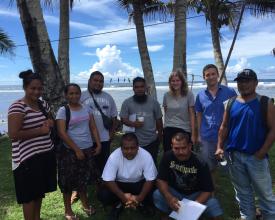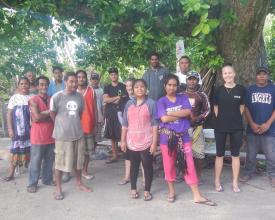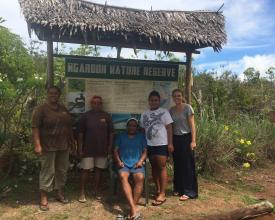
Empowering island communities: the use of cost-benefit analysis to support informed climate change adaptation decisions

Ecosystem based adaptation (EbA) solutions were identified and selected in a participatory process conducted across low-lying atoll islands and high islands communities of Palau and the Federated States of Micronesia (FSM). Cost-Benefit Analysis (CBA) was conducted to assess the costs and benefits of each EbA solution, in terms of welfare losses, due to the implementation of projects or policies, and welfare gains associated with the improved provision of ecosystem services.
Contexte
Challenges addressed
- Increasing risk of climate change impacts on community livelihoods and welfare, particularly due to water scarcity, storm damage and declining fisheries;
- Limited resources for climate change adaptation;
- Unknown effectiveness of ecosystem based adaptation solutions
Beneficiaries
Eight island communities in Micronesia as well as their municipal and state governments.
Emplacement
Traiter
Summary of the process
The building blocks “identifying EbA solutions through participatory assessments” and “communicating EbA solutions and trade-offs to stakeholders” are closely connected. A key feature is that the community members are directly involved in both identifying potential EbA solutions and in understanding and discussing the outcomes of the CBA. Moreover, much of the information used to conduct the CBA is obtained directly from members of the community through household surveys and expert interviews. As a consequence, there is a high degree of understanding and ownership of the results. This interaction between the building blocks helps to generate interest in the EbA selection process from the earliest possible stage.
Building Blocks
Identifying EbA solutions through participatory assessments
The identification of socially, economically and environmentally viable EbA solutions for each community were identified through:
(1) local participatory assessments to identify threats and potential solutions;
(2) household surveys to collect information on income sources and dependence on natural resources and
(3) social cost-benefit analysis (CBA) to explicitly compare the costs and benefits of adaptation options including impacts on ecosystem services.
Enabling factors
Historically, Micronesian communities have relied on ecosystem services and the connection with ecosystems and nature is still strong at present. This strong connection, coupled with ownership and local knowledge, was the main driver of EbA acceptance and application. The grass-roots approach allowed the identification of traditional resource uses, which were generally associated with sustainable practices.
Lesson learned
a) Participatory meetings were the essential settings for different stakeholders to come together and commit their time, as a community, for maintaining and managing their island ecosystems;
b) Using a participatory approach helped to reinforce the traditional governance system and enhance accountability and ownership of island communities;
c) active participation strengthened EbA solutions by acknowledging the relevance of adaptation to climate change for individuals, households and the entire community.
Steps towards effectively communicating EbA solutions and trade-offs to stakeholders
It is important to communicate the results of a complex analysis such as a cost-benefit analysis (CBA) in a non-technical way. Outcomes were reported to communities in the form of key messages encompassing the effects of EbA on community welfare, traditions and customary rules. For instance, restoring historical wells for provision of water during climate emergencies also comes with social benefits, such as maintaining historical and customary sites. Similarly, the EbA solution for watershed protection also helps to protect areas used to provide plants for traditional medicinal uses. We found that an effective way to communicate solutions, synergies and trade-offs is to tap into traditional uses of services and resources from the ecosystems.
Enabling factors
Support from local NGOs, Communities interest in challenges and opportunities
Lesson learned
a) It is crucial to break down CBA results into non-technical language, through key messages that spell out benefits and costs, in order for individuals, households and community to weigh challenges and opportunities of EbA solutions;
b) it was important to report benefits as opportunities in terms of capacity building, alternative source of income or livelihoods and describing welfare improvement for households and community;
c) where possible, presenting costs in terms of time that communities should commit for implementing and enforcing a solution (e.g. maintaining wells, vegetation strips, etc.) improve understanding of the results.
Impacts
Comparing different adaptation solutions in terms of monetary and non-monetary benefits empowered Palau and FSM communities to take on informed decisions on which adaptation project responds better to their need.
Results on EbA adaptations such as revegetation to control erosion, management of waste to reduce contamination of surface waters, or land planning are among the solutions that watershed sites in Palau and Micronesia took on board based on the CBA results.
Low-lying coral atoll communities have pondered the establishment or implementation of marine protected areas vs. enhancing agriculture vs. managing water resources. For instance, the atoll of Pakin (FSM) is implementing a dry litter piggery because this solution that has greatest economic benefits through the reduction of water contamination and the decrease of pigs impacts on crop production.
Importantly, CBA highlights additional benefits associated with climate change adaptation strategies providing communities with knowledge on the flow of services from managing, conserving or restoring an ecosystem. For Micronesian communities, this information is extremely relevant, since cultural identity is deeply linked to ecosystems goods and services.









